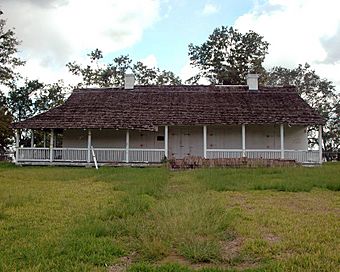Old Spanish Fort (Pascagoula, Mississippi) facts for kids
|
La Pointe-Krebs House
|
|

Main facade in 2006
|
|
| Location | 200 Fort Street Pascagoula, Mississippi |
|---|---|
| Built | circa 1757 |
| Architectural style | French Colonial |
| NRHP reference No. | 71000452 |
Quick facts for kids Significant dates |
|
| Added to NRHP | 1971 |
The LaPointe-Krebs House is also known as the "Old Spanish Fort" or "Old French Fort." It was built near Pascagoula, Mississippi, on land given to Joseph Simon dit La Pointe, a French Canadian.
Experts believe construction started around 1757. This makes it the oldest historic building still standing in Mississippi. It is also the only French colonial-era building in the state. Scientists used a method called dendrochronology to figure out the age of its wooden parts.
This house is the oldest scientifically proven building on the Gulf Coast of the United States. It was added to the National Register of Historic Places in 1971. In 1984, it became a Mississippi Landmark. Today, the LaPointe-Krebs Foundation owns and runs the house as a museum.
What Does the LaPointe-Krebs House Look Like?
The "Old Spanish Fort" was not a military fort. It was a one-story house with three rooms. The building was about 37 feet (11.3 meters) wide and 62.25 feet (18.97 meters) long. Its walls were very thick, about 18 inches (45.7 centimeters).
The house was built using strong longleaf pine wood for its frame. The oldest parts of the walls are made of a special concrete. This concrete was created using crushed oyster shells. Later additions to the house used a mix of clay and Spanish moss, called bousillage.
By studying the wood, experts found that the central room's wood dates to 1757. Wood from the east addition dates to 1762 and 1772. It's possible that wood from older buildings was reused, perhaps after a big hurricane in 1772. The western addition was built around 1820.
The house had porches on three sides. These porches were held up by square wooden posts. The roof was a gable style, covered with wooden shingles. There were two brick chimneys, covered in stucco. The original house had one large room and two smaller ones. The floors were made of oyster-shell concrete. In 1820, wooden boards were added on top.
The History of the LaPointe-Krebs House
Between 1713 and 1717, Joseph Simon dit La Pointe received land near the Pascagoula River. He was one of many Canadians who moved to Pascagoula from the Mobile Bay area. His land was first used to raise cattle. Later, it became a plantation. On this plantation, people grew indigo for blue dye and wax myrtle for candles.
Joseph La Pointe used enslaved people to work on his plantation. First, he enslaved Native Americans, and later, he bought enslaved people from Africa.
La Pointe passed away in 1751. His daughter, Marie-Josèphe, and her German husband, Hugo Ernestus Krebs, then took over the property. They continued to run it as a plantation. Enslaved African people were forced to produce crops like rice and cotton. A traveler named Bernard Romans wrote that Krebs even invented a cotton gin. This was more than 20 years before Eli Whitney's famous invention in 1793.
The house got the name "Old Spanish Fort" during the late 1700s. At that time, Spain controlled the Mississippi Territory. The house was used as a protected home by Don Enrique Ginarest. He was a Spanish Army officer who married Hugo Krebs' granddaughter.
The descendants of Hugo Krebs owned and lived in the house until 1914. Today, the LaPointe-Krebs House is a museum. It teaches visitors about the history of Pascagoula and Jackson County.
Images for kids







